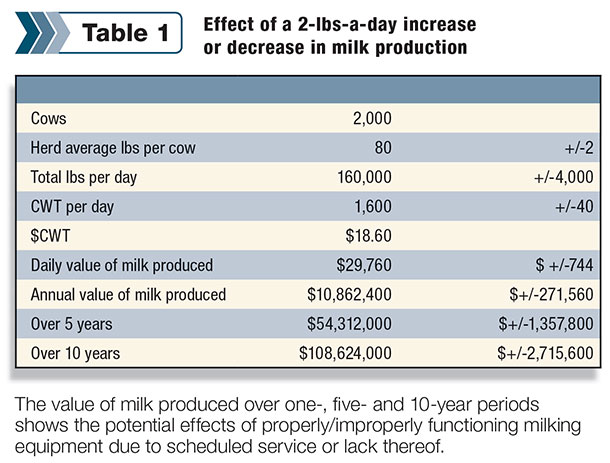Just like our trucks and tractors, milking equipment requires regular service to ensure it operates optimally and safeguards the health of the herd. There are many benefits associated with a proactive approach to scheduled service in the milking parlor. The payback associated with a scheduled service program can be seen in the form of increased production and less downtime due to unplanned interruptions in the milking process.
This increased efficiency will decrease the total cost of ownership over the life of the equipment. With the volatile milk and feed prices of recent years, producers cannot afford to have their milking equipment performing at less than the highest level.
Scheduled service and animal health
When a milking parlor is installed, it undergoes many tests to make sure it can safely milk animals according to National Mastitis Council (NMC) standards. After the first milking, the pipeline is cleaned two to three times per day with chemicals that will – over time – degrade the rubber, silicone and plastic components in the system.
If you can see cracks in the rubber hoses, gaskets or seals with your naked eye, just imagine what they look like under a microscope. The crevices created over time by sanitizing chemicals not only create an excellent place for bacteria to flourish but also create air leaks. It is well-known that bacteria in the milking system can adversely affect profitability and overall herd health.
Air leaks over time can lead to a change in the system vacuum, which can directly affect animal health in the form of a high somatic cell count (SCC). A milking system is set up to provide optimal vacuum stability in the milking process, and when air is introduced, the system changes.
The parlor that was set up for optimal milk production is now altered, and this can lead to a multitude of herd health issues along with lost milk production. When the vacuum level drops in the milking process due to leaks, it can lead to increased unit on time. A milking parlor that is dimensioned correctly will ensure the animals are milked properly, helping increase parlor throughput.
The scheduled replacement of key wear and tear items, in addition to frequent pulsation and vacuum level checks, can help ensure parlor performance and improve milk quality.

Proactive vs. reactive
There are many benefits to a proactive approach to scheduled service when compared to a reactive approach. Proactively scheduling service can lead to less downtime, which can help s profitability.
Here’s how to estimate the cost per hour of downtime at your dairy:
(Number of cows x herd average in pounds) / Milk price in hundredweights = Production per hour
(Production per hour x Milk price per hundredweight) / Hours of operation in a day = Cost per hour of downtime
Let’s do the math on a dairy milking 2,000 cows with a rolling herd average of 80 pounds. If the milk price is $18.60 per cwt and the dairy is milking 23 hours per day, the cost per hour of downtime is $1,293. Keep in mind while the dairy isn’t milking due to an equipment issue, the employees are still being paid and the cows are still eating.
If a producer takes a proactive approach, he or she can budget annual costs associated with scheduled service on the parlor. Most equipment dealers who service milking equipment will provide annual quotes for the parts and labor needed for scheduled service on a milking parlor.
Many times, the rates charged for scheduled service are lower due to the fact that the service is a planned event and takes place during normal business hours. This is a good situation for the producer and the service provider. Additionally, producers can customize a program for their dairy.
Taking a reactive approach to scheduled service typically means the equipment is not maintained through regular service, which makes it hard for a service technician to determine the source of the problem.
A reactive situation occurs when a problem arises on the dairy and only then is the call for service made to the service provider. This can lead to higher costs associated with the service call and frustration on the part of the dealer and producer.
After-hour service calls are inherent with operations that run 24/7, but the goal of most producers is to limit the occurrence. In an industry where efficiency is rewarded, taking a proactive approach to scheduled service is fast becoming the standard mode of operation.
Cost of scheduled service
The costs associated with a scheduled service routine will vary depending on the equipment installed on the dairy. In my experience, a scheduled service contract will be 0.5 to 1 percent of the total revenue generated on the dairy. This will vary slightly from one service provider to another depending on, for example, labor rates, milking equipment and the size of the dairy.
The focus of scheduled service should revolve around the wear items in the parlor such as rubber goods that come into contact with milk or cleaning chemicals, pulsators, milk meters, vacuum pumps and milk pumps. The pulsators should be checked and graphed monthly to ensure proper stimulation in the milking process.
Qualified service providers will have the necessary equipment and technical training to give you a full diagnosis of your pulsation system. It is important to have your service provider perform an annual NMC test to determine the condition of the milking parlor and make necessary changes in accordance with NMC test results.
Potential payback
The potential payback for having a scheduled service routine is less downtime associated with equipment failure or animal health issues. In addition, most mechanical problems can be avoided with preventative maintenance.
In many ways, scheduled service can be seen as an insurance policy to safeguard herd health and milk quality. A scheduled service routine will not eliminate breakdowns, but the chances that unplanned interruptions occur will drop dramatically.
Conclusion
Producers need every edge they can get, and I believe making sure the milking equipment is properly maintained on a schedule puts them in the best position to succeed. This will help ensure animals are being milked in a safe manner, which leads to increased production as well as less downtime due to unplanned interruptions.
Milk production continues to increase year after year, and this is due to many factors – including advancements in milking equipment technology. That technology helps producers milk more cows in less time and increases the amount of milk harvested per cow.
A scheduled service program will ensure the equipment can continue to milk the cows in a safe manner, while limiting downtime and increasing production. PD

Brett Olinger
General Manager
DeLaval Dairy Service






